#love how you can see where the natural mangroves and estuaries used to be are not there now
Explore tagged Tumblr posts
Text
the intimate tension between me and the storm surge inundation map

#the only source of comfort is of right now the prediction for my neighborhood#is about the same as what we got with Ian#not ideal at all but that's what we've prepared for#and we know it won't likely go into the house if it stays that way#the shed will flood again#but we rented a storage building at higher ground and put a lot of stuff into it#that is my only source of comfort right now#love how you can see where the natural mangroves and estuaries used to be are not there now#bc those are natural barriers#but the developers that came here during the 40's-60's were like? natural barrier? no! McMansions and yacht clubs!
1 note
·
View note
Text
Venturing into Indonesia and Beyond: Setting up a Biotope
In our journeys through the hobby, one way or another we will come across the term “biotope”, which is a miniaturized reproduction of a fish’s natural habitat in a captive setting. You’ve most likely seen them before without even knowing it. Think about the last time you went to the aquarium and recall the exhibits you saw. All the fish were organized by where they lived, most of the tanks probably had some real or fake plants, rocks, and driftwood. There may be resin stone outcroppings built into the background and sides to replicate the bottom of a Rift Valley lake, or fake mangrove roots choking a still water way to mimic an estuary where many brackish fish live. Even the saltwater tanks are constructed in a way that copies an approximate image of where that fish came from. Like a good zoo, a good aquarium will want to showcase the fish in the most enriching environment they can while also educating the public, and that usually means that they will replicate a fish’s home. Sometimes seeing fish like this at an aquarium can change your perspective on how to keep them, and you may want to set out and adjust their living space as you think is necessary for them to be happy, or it inspires you to want to start up a whole new tank for a specific fish or multiple species from a specific river, lake or country and make your own mini-aquarium at home. This can seem like a daunting task, and it may sometimes be hard to know where to start, and I won’t lie, there is a lot of time and research devoted into this, but the payoff is extremely rewarding.
WHERE DO I START?
Generally, it’s like planning any new tank, but in this instance, you’re going to have a narrower focus. You usually start out knowing at least one of the fish you want to keep, so you look up where they are from. With that knowledge, you can begin to find other fish from that same area. Fish Base will be your new friend in this situation. NOTE: You won’t want to exclusively use Fish Base for things like caresheets, but it’s a great site for finding different species that inhabit the same bodies of water or country as your selected species.
For example, say you know you want a pearl gourami (Trichopodus leerii) as your centerpiece in your new 75 gallon tank but you don’t want to have one large tank with just 3 fish in it (1 male and 2 females). You’ll pop on over to Fish Base and look them up, seeing where they are from along with some basic care information such as water parameters and a habitat description.

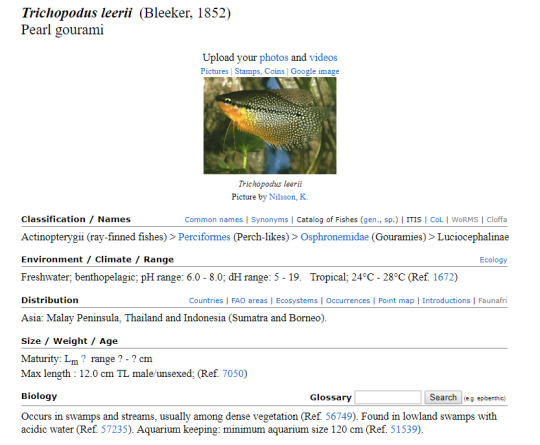
You can scroll down to countries to see a map of their range, which includes native and introduced.

From there, you can choose which country you want to focus on. We’ll choose Indonesia. You can click on the links and take a closer look into Indonesia if you’d like, but you’ll go back to the search screen at Fish Base.


I find it easier to search with the above selections marked off.
From here, you’re basically going hunting. This can take you a while, you can narrow down which fish interest you and check to see if they are compatible with the pearl gourami. You already know you’re going to need a heavily vegetated tank with soft, acidic water and minimal lighting, so you’re looking for fish with similar needs, while also taking temperament into account. You don’t want aggressive, boisterous fish that will scare the pearls away during feeding, so you’re going to be looking for peaceful, small fish that won’t bother them. You settle on the chili rasbora (boraras brigittae), kuhli loach (pangio kuhlii) and red line rasboras (Trigonopoma pauciperforatum) as all these fish require dimly lit, soft, acidic waters with marginal current and dense vegetation with the bonus of being peaceful and small.
OKAY, SO IS THERE MORE THAT I NEED? WHAT SHOULD THE TANK BE FILLED WITH OTHER THAN JUST, WELL, FISH?
Great! You know your stock! But what do you furnish it with? And how do you find this out? At this point, you’re going to start googling. A lot. You can use youtube to find videos that may be uploaded from the natural habitats the fish are from, in this case, Sumatra and Borneo.
youtube
A lot of the time, you won’t find nice examples that you can see, but you’ll read descriptions that you can visualize. What does soft water usually have? Decaying vegetation that lowers the pH and creates soft water with a lot of dissolved organic solids, so leaf litter and driftwood would clearly be required. These fish require densely planted, dimly lit water. Finding out what plants you need is as simple as googling “aquatic plants from Borneo/Sumatra/Indonesia”. You’ll find that a lot of the plants are the common crypts, which do well in dimly lit tanks and aren’t particularly fussy to begin with. There’s a lot of diversity within crypts, so choose them as you see fit. A lot of the time, plant species will be entirely up to you and how you plan to scape your tank. Then comes the matter of substrate, which can sometimes be hard to find information on, though many caresheets nowadays will mention what substrate is best for this fish. At times you might not be able to replicate the loamy bottom of Lake Inle, so you can choose to either go with sand or try a dirted tank. Sometimes it’s simple, a hillstream or river tank will be comprised of sand and gravel, as the water movement in the wild will erode the rocks and crack them against one another, creating fragments that turn into smaller and smaller fragments over time.
If you want a different kind of biotope, you can start with a totally different kind of habitat and apply the same basic search methods. Maybe you want to stay in Indonesia but want a hillstream tank? Or an African tank? French Guyana? The same way you searched for the pearl gourami tank, you can search for all these others. If you read that a reed fish lives in soft, acidic swamps that are heavily planted with low oxygen content, then you’re going for a tank that has almost no water movement, a somewhat lower water line, and filled with a lot of leaf litter, some driftwood and lots of plants. If you want emerald dwarf rasboras and read that they live in a relatively cool, karstic, shallow but vegetated lake in Myanmar, then you’re going to be looking into a hard water tank with plants that can be found in that lake. This example is Lake Inle, where these fish are exclusively found in, so your entire focus will be pretty much on this lake, with some information on plants from Myanmar. You can even go looking into your own backyard and get hands on, planning a biotope based on native fish and learning something about your local wildlife and habitats.
WHAT ARE THE BENEFITS?
Some fish need to be kept in a natural habitat because that’s all they know, and it makes them more comfortable that way. If you have a wild caught fish in your tank, you’ll want to make sure that your tank is as close to where they came from so they can thrive. What is thriving? Beyond being alive, thriving for a fish means it displays its natural behavior, it eats regularly without issue, and may even attempt to spawn in captivity if there’s another sex of the same species in the tank. This is as close as you can get to determining whether or not a fish is “happy”.
Even if your fish is not wild caught, they will still benefit from an environment from which they evolved in over thousands or millions of years. Some fish may have never inhabited a vegetated peat swamp in their entire lives because they’ve been captive bred, but if you keep them in hard, alkaline water with no plants, their lives will be shortened and they will be unhappy and unhealthy, unable to display natural behaviors. Think of the betta splendens, a fish very much removed from its natural habitat nowadays. For a moment, pretend you have a perfectly healthy plakat. It doesn’t have the dragon scale mutation so it’s not going to be prone to tumors or cancer, it has short fins that bettas naturally have so it’s able to move about quickly like a betta is hard wired to. A betta without décor or with a sparsely planted tank maybe shy or inactive, eat irregularly and be stressed, susceptible to illness and disease. I’m not saying this is the root cause to the issues bettas have, that’s a nebulous topic that can be another 1700 word post on its own, but in this situation we’re imagining the ideal, healthy betta. If you place this betta in a habitat that more closely mimics the one the b. splendens evolved within, it will feel more comfortable and display more of the betta-y behaviors we all know (and love). It’s difficult to change what a fish needs in its environment to thrive, a fish has evolved over time to fill a niche in a habitat and placing it within a captive setting won’t change their instincts or needs.
But does this mean every fish needs to be in a biotope? That all fish should be separated by their location, regardless of the fact they can inhabit the same conditions that a fish from another continent does?
Nope! Biotopes, for the most part, are for the pure aesthetics of the keeper. You ultimately don’t have to find plants specific to a river, lake or country, that’s entirely up to you if you want to do that. You don’t have to place pearl gouramis with just chilis, red lines or kuhlis, you can place them with peaceful tetras, pencil fish, a pleco, corydoras and honey gouramis (which are from India, not Indonesia). A biotope is just a method of scaping a tank and keeping fish, it’s subjective. There are clear benefits to it, but those benefits can also be had by just furnishing a tank the right way. Put swords in a betta tank with rotala, barclaya, banana lilies and hygro, your betta will still feel happy and safe as long as there are a bunch of plants in there. A biotope is for you.
#fishblr#megs does guides#i literally just ripped examples from my own tank plans lmao#this was....really long?#took me two hours rip
117 notes
·
View notes
Text
Things To Do in Kasaragod to Refresh Your Connection With Nature.
Away from the crowds of South Kerala, pristine moments and things to do in Kasaragod in North Kerala. Featured image: Marieke Weller (Unsplash).
I landed up in Kasaragod on my quest to discover Kerala beyond the beaten path. As I swam in the Kasaragod backwaters (they are that clean!), kayaked amid pristine mangroves and learnt how terribly skilled I am at rowing a round coracle boat, I quickly fell in love.
If you make your way to North Kerala – and you absolutely SHOULD – set aside a few days for some unique things to do in Kasaragod to re-establish your connection with nature:
Watch the sunset over a unique estuary made by the Arabian Sea
Things to do in Kasaragod | Sunset over the Arabic Sea. Photo: JANUPRASAD.
Even though it was some eight years ago, on my first solo trip to Kerala, I still vividly remember that magical sunset. A boat maneuvered the pristine Kasaragod backwaters and deposited us on a sandy strip of land. On one side, the waves of the Arabian Sea roared. On the other, the backwaters gently flowed. We walked along, splashing in the waves, dipping our feet in the warm water.
And just as a the sun was about to sink below the horizon, we stood at what felt like the edge of the world. The Arabian Sea hugged the backwaters.
Turns out, the estuary on the Kasaragod backwaters is actually man-made. It was created by rice farmers who hoped to channel out the excess monsoon water from their fields into the Arabian Sea. But as nature would have it, the water level rose several times more during high tide, claiming the entirety of their paddies.
Also read: What India (and the World) Can Learn from Sustainable Tourism in Kerala
Kayak among mangroves and appreciate their role in the natural ecosystem (one of the most unique things to do in Kasaragod)
Things to do in Kasaragod | Kayaking in a mangrove. Pic: Ivana Cajina
Mangroves are nature’s bridge between land forests and aquatic ecosystems. These trees and shrubs grow in salty terrain. They serve as breeding and feeding grounds for marine life, recycle nutrients and help prevent soil erosion. They tend to provide protection to coastal communities against cyclones and tsunamis. And are estimated to absorb more CO2 than most forests!
But most of all, they are some of earth’s most unique creations. With their roots above water, they’re a sight to behold and a paradise for birdwatching. As you kayak among the mangroves of Kasaragod, notice the beautifully meditative feeling of silently drifting along.
Unfortunately, 40% of mangrove forests on India’s west coast have fallen prey to urbanisation and shrimp farming. Something to dwell upon as you row.
Also read: My Alternative Travel Guide to Goa
Row a coracle boat under the moonlit sky
Things to do in Kasaragod | Try to row a coracle boat. Photo: Alka Jha
I’ll never get over my fascination with those round coracle boats. Traditionally made of interwoven bamboo, used by fishermen in southern India. They look easy enough to row, but each time I try my hand at one, I go round and round in circles!
And so it was on the Padanna backwaters of Kasaragod. Under a half moon and a fairly dark sky shimmering with stars, I rowed a coracle boat as little fish jumped around me, shining in the moonlight. What a feeling!
Also read: Offbeat Kerala: 11 Travel Experiences to Inspire the Artist in You
Catch a Theyyam performance in the land where it was born
Things to do in Kasaragod | Catch a Theyyam performance. Photo: Manyu Varma
Although the ancient storytelling artform of Theyyam can be witnessed across Kerala now, it was here that it began some 1000+ years ago (some say in the neolithic times!). Through extravagant face art, costumes and headgear coupled with awe-inspiring ritual dance, theyyam evokes the tribal spirits of the ancestors that once called this land home.
Every winter, the temples and some homes of Kasaragod come alive with the awe-inspiring Theyyam ritual. The practice is passed down from elders in each family – and many artists begin learning in their pre-teen days to perfect the act.
Also read: 15 Responsible Travel Tips for Authentic, Meaningful Experiences on the Road
Swim in the Kasaragod backwaters
Things to do in Kasaragod | Swim in the Kasaragod backwaters. Photo by Marieke Weller on Unsplash.
Sounds like no big deal. But the Kasaragod backwaters are perhaps the only ones in Kerala clean enough (and devoid of houseboats) for a refreshing dip. The sand below is soft and solitude is a given. Look up to see soaring eagles or keen kingfishers eyeing their prey. Hear the rustling of the palms. After all, it’s these little joys that live in on our travel memories.
Also read: What the Kumaoni Folk of Uttarakhand Taught Me About Life
Rejuvenate at an eco-friendly retreat on perhaps Kerala’s most spectacular island (one of my fav things to do in Kasaragod)
Things to do in Kasaragod | Stay on Kerala’s most spectacular island.
Until I arrived at Oyster Opera, I only saw houseboats when I imagined Kerala’s backwaters. But this eco-friendly retreat, set up by the visionary Gul Mohamed, added a new dimension to the backwaters for me.
On this stunning island, surrounded by the breezy waters and swaying palms, local materials have been used to recreate traditional architecture with creature comforts. Think laterite stone huts, red tiled roofs, even a floating thatched hut. Feast your eyes and tastebuds on incredible local food – easily catered for vegan travellers. Then get ready for some hammock, swimming or beach bumming time!
Also read: Awe-Inspiring Uttarakhand Homestays to Tune Out of Life and Tune Into the Mountains
Feel like a cast-away at a beach between the backwaters and the Arabian Sea
Things to do in Kasaragod | Image: J A N U P R A S A D on Unsplash.
People often claim that North Kerala has some of the best beaches. Though the beaches in Kasaragod might not make my favorites, I wouldn’t pass up the chance to have high tea surrounded by palm trees. As the Arabian Sea gushes nearby and the backwaters serenade me.
Luckily, many of Kasaragod’s beaches are still deserted. Unknown to the beer-drinking, loud music-playing herds of tourists. Which is why I’ll refrain from naming them here. So when you land up on one, you can feel like a cast-away too!
Also read: A Traveller’s Guide to Gujarat’s Best Kept Secrets
Have you discovered any unique things to do in Kasaragod?
PIN this post!
The post Things To Do in Kasaragod to Refresh Your Connection With Nature. appeared first on The Shooting Star.
Things To Do in Kasaragod to Refresh Your Connection With Nature. published first on https://airriflelab.tumblr.com
0 notes
Text
Journal 9 (11/14/18)
Section 1 - Overview
Our final field trip was a short outing to Lovers Key at Fort Myers Beach. Lovers Key is both a beach and a state park. It got its name because when it was first founded, it was only accessible by boat, so young couples would sneak out to the island for a romantic getaway. There are three other keys/islands that surround the area of Lovers Key: Inner Key, Black Island, and Long Key. Lovers Key is a popular location to collect shells because of their abundance along the shoreline.
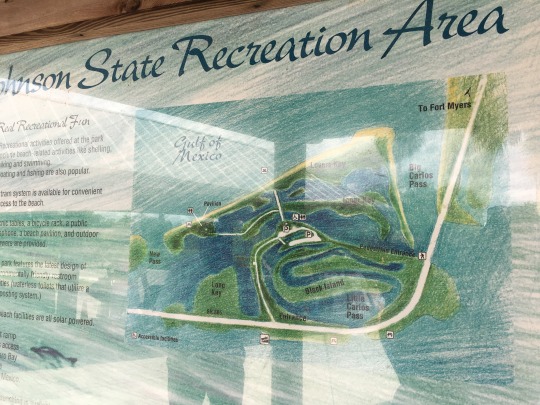
The map of Lovers Key and its surrounding islands.
Section 2 - The Boardwalk
In order to get to the beach at Lovers Key, we had to walk along a boardwalk. The boardwalk was a bridge over the water and it was surrounded by mangrove trees. The naturalist told us about the three main types of mangrove trees in Southwest Florida: red, black, and white. Red mangroves are at low levels and stay close to the water’s edge. Their roots stick out of the ground and grow out towards the water. Their leaves are larger and more pointy compared to the leaves of other mangroves. Black mangroves stay in areas that are slightly highers than red mangroves so that their roots can get air during low tide. Their roots are horizontal. The leaves of black mangroves are opposite of each other and encrusted with salt on the hairy backs. White mangroves live at the highest area, staying away from the water at low tide. They have no visible aerial roots. White mangrove leaves are yellow-green and have small sugar glands at the base. White mangroves also blossom white flowers in the spring. We also learned about propagules, which are mangrove seedpods that remind me of string beans. The mangroves release the seedpods into the water, where it must stay for a certain period of time. Once the propagule was found a favorable area, it will attach and begin to grow roots. The naturalist taught us a rhyme to remember the difference between the mangrove trees:
Red, red, point head Black, black, lick the back White, white, goes on tight
As we continued along the boardwalk, the naturalist told us about estuary systems. Lovers Key is an estuary, which is where a river and the ocean meet. Estuaries have brackish water, meaning it is a mixture between salt and fresh water. These types of systems are popular breeding grounds to many different species of fish, birds, plants, and other marine life. The naturalist also took a moment to discuss red tide with us. She explained that it is a harmful development of algae that produces toxins that kill sea life and cause dangerous circumstances for both nature and humans. Red tide infects many fish and other marine animals, which in turn cause the animals that eat the fish to become sick as well. This causes a strain on the marine industry, since it is unsafe to eat fish infected with red tide. Also, red tide emits harmful toxins into the air, which is dangerous for marine life and humans. There are many misconceptions to the causes of red tide. Many people believe that it is a man-made phenomenon caused by pollution. However, red tide is a naturally occurring affect that happens almost every year during the summer. However, what’s different about this year is that we haven’t seen red tide this intense and close to shore. The reasoning behind this could be the unenvironmentally friendly habits of humans. Hopefully we will learn a lesson from this experience about taking care of our ecosystems.
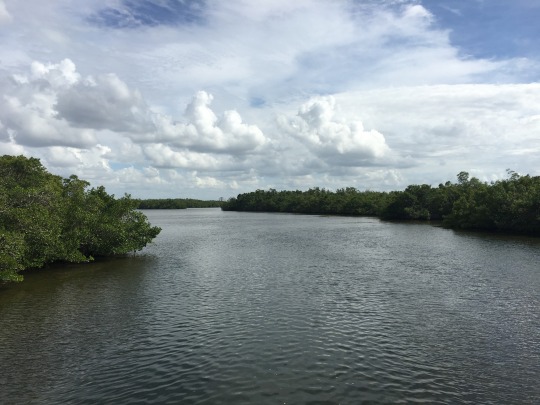
The view upon walking across the boardwalk.

I was amazed by how clear the water was as we walked along the boardwalk. You could see right to the bottom! The beaches where I’m from on the east coast of Florida are never have water this clear; it’s usually cloudy and rough.
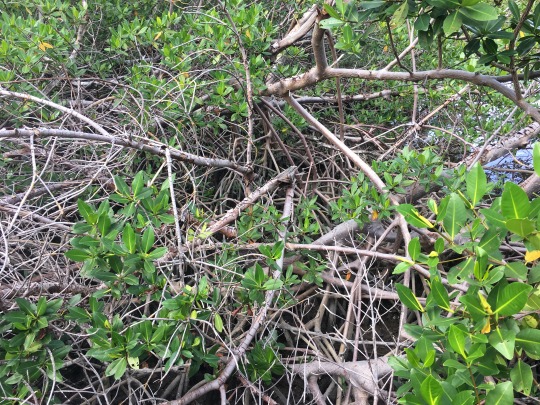
The roots of a red mangrove tree. They have prop roots, which means they stick out above the ground.

These are the leaves of a red mangrove tree. They are long and pointy; the front and back is smooth and shiny.

Another view of the mangrove trees as we got closer to the beach.
Section 3 - The Beach
I very much enjoyed our short walk along the beach. The air was cool and it wasn’t humid like usual. The sun was blocked by dark clouds, so it wasn’t hot at all. The wind was strong but I enjoyed the sea salt air as it blew through my hair. The sand felt nice on my toes and we fell behind the rest of the group as we searched for shells. I love going to the beach, so I genuinely had fun during this field trip. As we collected shells, we ran into an older woman who was also looking for shells too. She taught us how to safely store a sand dollar, since they are very fragile. She packed sand into a larger shell, placed the sand dollar into the middle, and gently cover it with more sand. We continued to chat with her and discovered that her and her husband were from Oregon and they were here on vacation. We told her that we were students on a field trip and briefly discussed the issues with the environment of Southwest Florida. After we said goodbye, I thought about all the interesting people that come to visit Florida for its beautiful beaches. I hoped that she felt inspired by our knowledge about environmental issues.

Our initial view and the first photo I took upon walking on the beach at Lovers Key.

The dark clouds covered the sun, which made the weather perfect. The light still reflected off of the water. The waves were crashing and the tide was a bit rough, but the sound of the waves was relaxing.

Another beautiful view of the beach. I didn’t noticed until I went home and looked back at the photos I took that somebody wrote “Lovers Key” in the sand.

A view of the water as we got closer to where the waves were crashing.

An overall view of the shells that covered the sand. I was amazed by how many shells were along the beach and I wondered how many there were and where they have all been.
Section 4 - Shell Identification
I found many interesting shells as we walked along the beach at Lovers Key. I picked these ten shells for my identification because I thought that they were the most unique. I have seen shells similar to these before, since I grew up visiting the beach often as a child. However, I never learned their names or anything about them. I took this opportunity to educate myself of the shells that I recognize from my childhood.

1. Sand Dollar - A sand dollar is a type of sea urchin that feeds on plankton and other organic materials. A live sand dollar is brown in color and is covered in tiny hairs. When they die, they turn white, like the piece shown above.

2. Broad Ribbed Cardita - These types of shells have radiating ribs that poke out and are usually scaley. The ribs have spots on them and cross to create bands. These shells are usually either purple or reddish-brown. Sea snails usually feed on broad ribbed carditas and their halves can be found on the west coast of Florida.

3. Cockle - The two halves of a cockle shell are symmetrical and they have evenly spaced ribs. They are able to shut completely with no space between. They usually live in buried sediment and are able to “jump” with their foot.
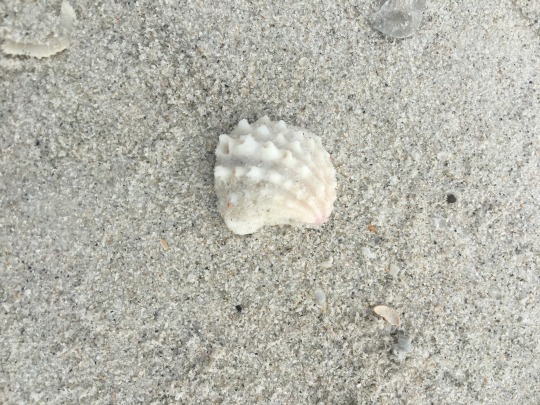
4. Spiny Jewel Box - These shells get their name from their shape; they look like little containers. The spines of this shell are very long while living in the water, but they quickly wear down once they reach the surface. They live on rocks and other rubble of the beach.

5. Scallop - Scallops are a type of sea mollusk that live on the ocean floor. They are able to move around by quickly clapping their shells open and closed. This allows them to migrate or escape from predators, like starfish. Scallops also have a ring of eyes around the tops of their shells. Their shells come in many bright colors, like purple, red, and yellow.
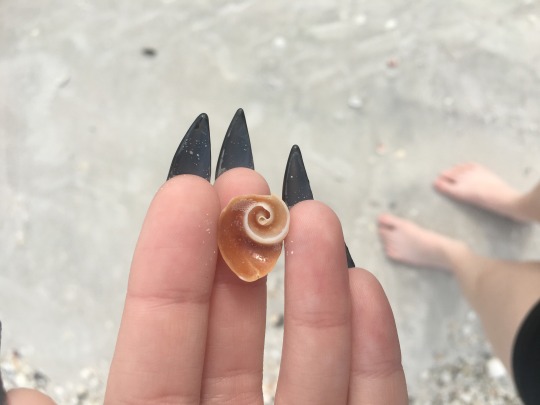
6. Shark’s Eye - This is the bottom of the shell, which gets its name from its appearance, which resembles a shark eye. A Shark’s Eye is a predatory sea snail; it digs through the sand for claims and other small shells. They eat their prey by drilling a hole through the shell and scrape out the meat. The snails live just below the shoreline and their empty shells are commonly found on the shore.

7. Florida Fighting Conch - This is the shell of a sea snail called the Florida Fighting Conch. The curved edges of the shell allow the eyes to look out from under the shell. There are typically nodules along the top of the shells. Florida Fighting Conchs use their feet to crawl and scare of enemies. They also live in shallow and warm water.
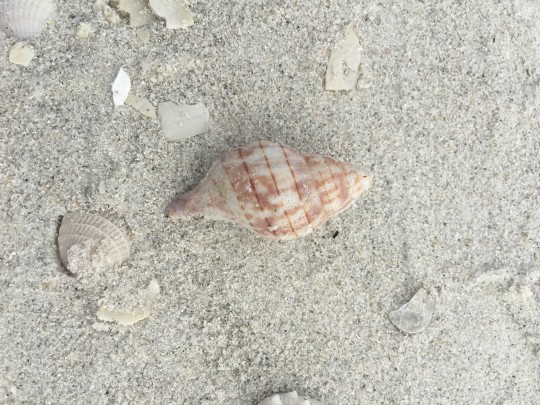
8. Banded Tulip - The banded tulip is a type of sea mollusk that lives off of a carnivorous diet. They are known to eat other conchs, shells, and even clams. They have “toothed” tongues that they use to dig a hole through the shell of their prey and they scoop out meat. Banded tulips are one of the most aggressive species of shells in Florida.

9. Lightning Whelk - This mollusc is a predator of the ocean. They feed on clams, oysters, scallops, and other shells. They have a foot that they use to pry open shells and suck the meat out with a tube-like tongue. Unlike most whelks and shells, their spiral curves to the left.

10. Buttercup - The buttercup has a smooth surface on the outside. They live in shallow waters and burrow beneath the sand. They filter feed and draw water in from a cavity on the surface. They are a popular prey of fish, crabs, and birds.
Section 5 - Black Island
The second half of our field trip continued on to Black Island, which is one of the islands that surrounds Lovers Key. The naturalist told us that Black Island is named after a pirate called Black Augustus, who sailed into hiding from American forces in the 1800s. He was a fugitive and hid his treasures on the island; he lived there for the rest of his life. The island is surrounded by additional estuary systems and mangrove trees. The naturalist told us that some of the most prominent species on the island are gopher tortoises. These animals dig deep burrows in the ground that were described as “condominiums”. Their burrows are underground tunnels that are connected by several “rooms”. many other species use gopher tortoises’ burrows as shelter as well, which is a perfect example of the biodiversity of Black Island. Without these tortoises, many animals would lose their homes. Gopher tortoise burrows are also useful during forest fires. During an emergency, animals can flee into the burrows, which are deep enough to protect them from the fires. Black Island is also home to many species of butterflies. There is a butterfly garden on the island, where butterflies are bred and released into the wild to increase the population. Although we only stayed on the island for a brief amount of time, I learned a lot about the history of Southwest Florida and the importance of keeping species safe.

The view on the nature trial as we walked through Black Island.

Black Island was covered with many different types of mangrove trees.
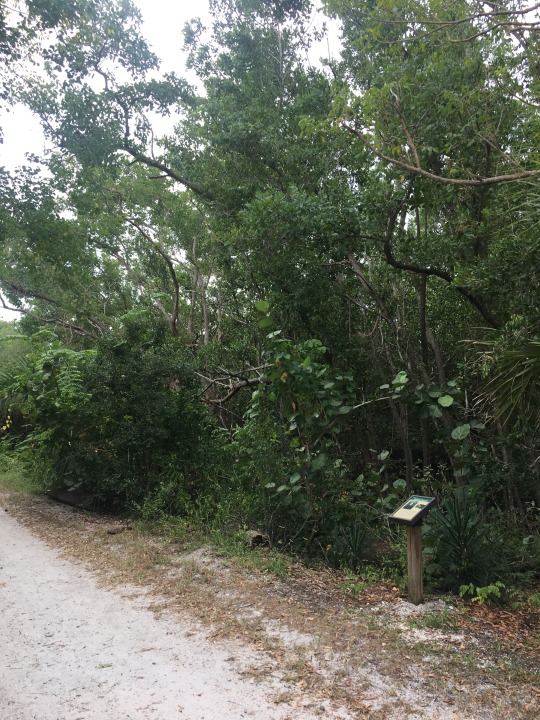
Additional vegetation along the nature trial.

The nature trial split off into many sections, although we only went down one path.

The view from the lookout point on Black Island where we stopped to reflect.

Information on the many butterfly species in Black Island and Lee County.

This was the center in the butterfly garden where butterflies are bred and released to increase the population. The small plants are used for the butterfly cocoons to develop. The butterfly in the top of the enclosure has recently escaped the cocoon.
Section 6 - Additional Photos of Interest
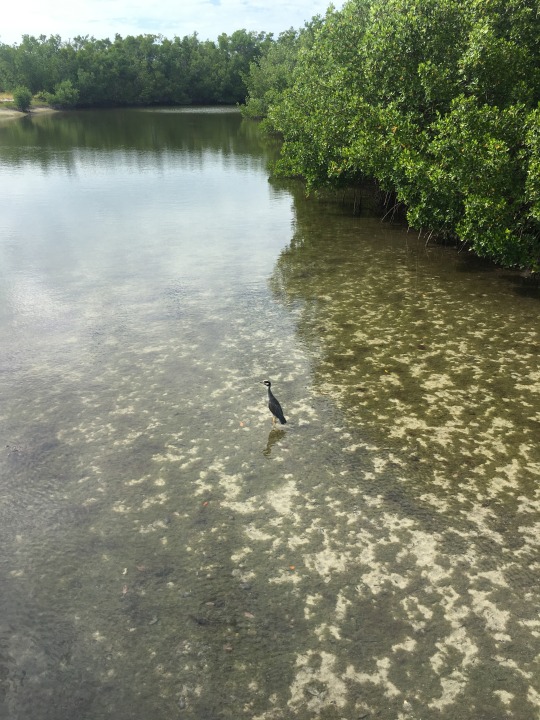
A bird in the estuary system of the boardwalk. This is the perfect ecosystem for marine life, due to its qualities for breeding and feeding grounds. The mangrove trees provide shelter and food for animals like this bird.
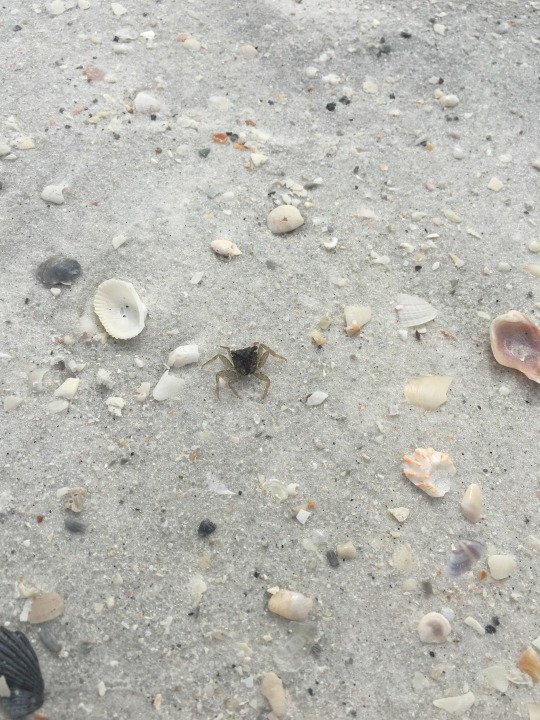
A tiny crab that we found scurrying across the sand as we were searching for shells.
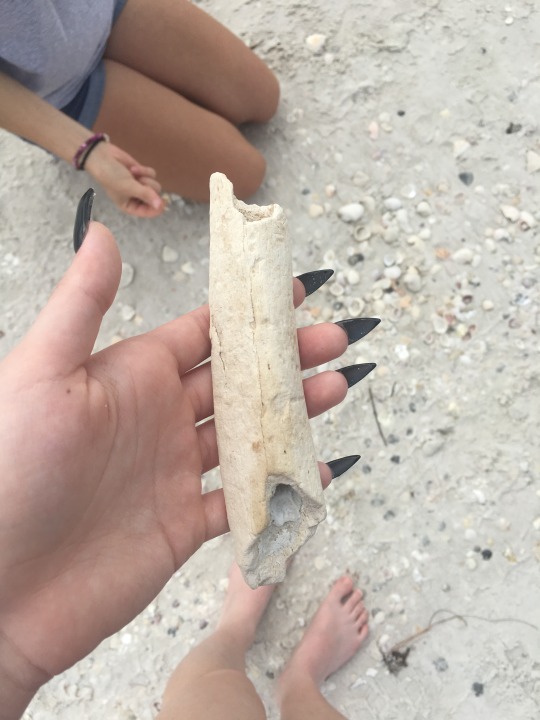
As we were looking for shells, Nicole found a object that closely resembles a bone. We studied the item by tapping it, looking inside and along the edges, and even smelling it. We asked a few other classmates what they thought it was and we got mixed responses; some said it could be a bone while others felt like it was a bleached piece of driftwood. I took the object with me and showed it to my forensic anthropology professor the following week. She is specialized in osteology and I knew that she would be able to tell if it was a bone. She informed me that this object looks very much like a bone, but she would be able to tell for sure if it were sawed in half in order to see the deposits of bone marrow. We both determined that it definitely is too large to be a human bone, so it must be from a sea animal. We could also tell that it was extremely weathered from wind, sand, and water. My professor also gave me an extra credit opportunity if I was able to do research and determine if this is in fact a bone and what kind of bone it is. I still have it with me and I hope to look into it when I have the time.
0 notes
Text
Chandragiri Fort – Kerala
About Chandragiri fort, Bekal
Weather: 22° C
Time Required: 1-2 hrs
Cost: Indians and SAARC Nationals: INR 5, Foreigners: INR 100
Open Time: 8:00 AM – 5:30 PM
Built in the 17th century by Sivappa Nayak of Bedanore, the Chandragiri fort lies in the Kasaragod District of north Kerala, the southern state of India. Now only a remnant of its original majestic form and protected under State Archaeology Department, the fort once used to be a powerful stronghold of the kingdom. Full of artistic and historical significance, this place is visited by locals as well as tourists for the breathtaking view of the estuarine that Payaswini river forms with the Arabian Sea. Flanked by coconuts and mangroves on both sides, it offers a magnificent sight to behold. If visited during the afternoon, one can witness a stunning view of the sunset as well from the Kizhur State Temple.
The fort has a colourful past, being the stronghold of the bedanore Naiks of South India against all other hostile forces during the 17th century. It has also seen the rule of the Mysore Sultan Hyder Ali, and then witnessed the British Colonialism like every other fort in India, intact or otherwise. The fort regained its roots in Kerala only after independence.
The Chandragiri fort does not have much to see but offers a much-needed silence for those who seek it. The grim and quiet corners of the mighty fort speak of its own turbulent history and let you soak in its glory. The sunset from atop is nothing short of a perfect frame for a photographer who wants to capture the unembellished beauty of nature.
The Chandragiri Boat Club nearby offers boat trips to the nearby islands and palm groves, and on some of the islands you can get down and camp. The local fishermen will accompany you in the boat rides, so you will get to know the unabridged stories of the locales, and any interesting story, legend or folklore about the fort, if there is any. If you want a lazy and unconventional way to spend a free evening while on the trip near Bekal or Kasaragod, the Chandragiri fort is your best bet.
History of Chandragiri Fort
The ruins of the massive 17th-century fort along the river Payaswini, also called Chandragiri River, has an eventful past story and has experienced a good many change of hands. Centuries ago when the river was considered to be the boundary between kingdoms of Kolathunadu and Thulunadu, the capture of the latter by the strong and powerful Vijayanagara empire led to the capture of Chandragiri town on this side of the river. It was only after the decline of Vijayanagara in the 16th century that an offshoot dynasty called the Ikkeri Naikkars rose to the power and took over Chandragiri. This dynasty, also called Bedanore Naiks declared themselves as independent rulers under the rule of Vengappa Nayaka.
For the defence of his kingdom against the many fighting dynasties of South India, Sivappa Naik built the Chandragiri fort in the 17th century. It was one of the few forts constructed during the same time by the Naik dynasty for the same purpose. Much later it fell into the hands of Hyder Ali of Mysore and then finally under British East India Company. The region, as well as the fort, was re-joined with Kerala after independence through the State Reorganisation Act of 1956.
Chandragiri Fort Boat Club
There is a bridge near the Chandragiri Fort on which visitors can take a peaceful stroll. The bridge is the starting point of all the speedboat, houseboats, and island camping and tours. The Chandragiri Boat Club offers the water vehicles and it is the job of the local fishermen to take you around the water through the islands and tell you stories and folklores of the place. In case you are not a local person, language might become a problem.
Things To Do Near Chandragiri Fort
The Chandragiri fort being in its ruins now preserved by the authorities, there is not much to do here. It is built on a small hillock more or less 50 metres above the sea level, covering as much as seven acres. It still has two underground passage, a well and a pond inside its fortified walls.
The topmost floor offers the most picturesque view of the Payaswini River slowly and lazily flowing into the calm Arabian Sea forming an open mouth estuary. Lined with lush greenery on both banks thanks to the coconut and grove forests, the scenery is absolutely stunning. Visitors can spend some time here taking in the view in front. The sea-facing wall of the fort has holes from canon ball attacks. It also offers an excellent panorama for the photographers to capture. The sight is serene and peaceful to spend an evening after sundown. It is particularly beautiful during sunrise and sunset.
The ancient Kizhur State Temple is very close to the magnificent fort from where you can witness a stunning view of the sunset. This temple also celebrates the festival of Pattu Utsavam, where a group of singers come together to sing in the glory of the God.
Located far away from any popular tourist spot, you will get the necessary peace and quietude if you are a silence loving traveller rather than a spot jumping tourist. However, you need to know the location and arrange to visit it because it is not usually included in tourism packages.
Places in Bekal
1. Bekal Fort 2. Bekal Fort Beach 3. The Bekal Hole Aqua Park 4. Valiyaparamba Backwaters 5. Nityanandashram Caves 6. Chandragiri fort
Location :
What could be more picturesque than a fort which is bordered by a river? Well, Chandragiri fort provides one with this rare sight. The scenic beauty of the lush green surroundings and the gurgle of the river flowing close by make one wonder whether Chandragiri is a fort or a palace.
Attraction :
To minute observation, the fort readily opens up its share of what could have been mighty dangerous locations for the enemy to enter.
The deep trenches which were once lined with piercing rods, the guillotine where executions took place, all cry out a history of war and death. For those interested in the murky smell of the past the fort is the ideal place to visit.
Attractions Here:
Chandragiri Cruises: Boat trips to nearby islands and palm groves. Boarding Point – Chandragiri Bridge. Chandragiri Boat Club: The Boat Club offers speed boat rides, houseboat cruises, island camping and wildlife tours in the hinterlands. Fishermen near the Chandragiri Bridge will give you a ride on the backwaters and arrange trips to nearby islands.
How to Get there
By Train :
Nearest railway station: Kasaragod, about 7 km
By Air :
Nearest airport: Mangalore Airport (Karnataka) about 67 km
Photo Gallery :
Chandragiri Fort from the top
Chandragiri Fort – Kerala
Chandragiri fort
Chandragiri Fort – Kerala Chandragiri Fort - Kerala About Chandragiri fort, Bekal Weather: 22° C Time Required: 1-2 hrs Cost: Indians and SAARC Nationals: INR 5,
#Chandragiri Fort - Kerala#Chandragiri Fort - Kerala details#Chandragiri Fort - Kerala explain#Chandragiri Fort - Kerala gallery#Chandragiri Fort - Kerala photos#Chandragiri Fort - Kerala tour#Chandragiri Fort - Kerala tour details#Chandragiri Fort - Kerala tour guide#Chandragiri Fort - Kerala tour tips#Chandragiri Fort - Kerala tourism#Chandragiri Fort - Kerala wonder#INDIA TOURISM
0 notes